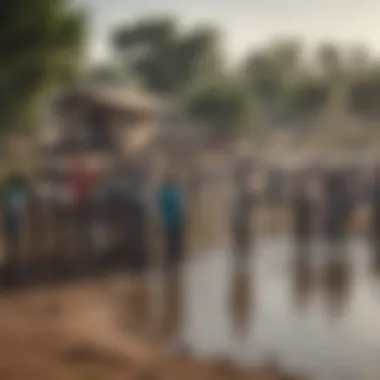Confronting Water Scarcity in Africa: Urgent Solutions


Intro
Africa faces a severe scarcity of water, significantly affecting its social, economic, and environmental health. Water scarcity arises from a mix of climatic changes, population growth, and inadequate infrastructure. Approximately 300 million people live without access to safe water. This article outlines not only the challenges posed by the shortage but also viable solutions in sustainable water management.
Article Overview
Purpose of the Article
This article aims to elucidate the complexity of the water crisis in Africa. By examining root causes and the benefits of water, it seeks to inform policymakers, researchers, and educators about the gravity of water scarcity. It will also highlight innovative practices and case studies that provide effective strategies to face this ongoing crisis.
Relevance to Multiple Disciplines
The topic of water availability transcends numerous disciplines:
- Environmental Science studies the ecosystems impacted by water scarcity.
- Public Health examines the direct effects of water quality on community health.
- Economics analyses the economic burden caused by limited access to such an essential resource.
Researchers in all these fields can gather crucial insights into how water scarcity extends beyond mere supply issues.
Research Background
Historical Context
Historically, African societies have relied on local water sources for agriculture and daily use. However, rapid urbanization, industrialization, and climate change have strained these resources. In many regions, the traditional ways of water management have become obsolete, necessitating urgent reforms.
Key Concepts and Definitions
Understanding fundamental concepts is vital for discussing water issues.
- Water Scarcity is a lack of sufficient fresh water resources to meet the demands.
- Sustainable Water Management involves practices that ensure long-term availability and quality of water.
- Ecosystem Services refer to the benefits provided by the natural environment which must be preserved to maintain water security.
In summary, the pressing need for water in Africa requires immediate attention from various disciplines. The article will develop these themes further, providing insight into the challenges and offering actionable solutions.
Preamble
Water scarcity is one of the most pressing challenges facing Africa today. The continent is home to over a billion people, many of whom lack access to clean and safe drinking water. This situation not only affects individual health and well-being but also has broader implications for public health, agriculture, and economic development. In this article, we will explore the factors contributing to water scarcity in Africa, the socio-economic consequences of limited water access, and the innovative solutions being implemented to address these challenges.
The significance of this issue cannot be overstated. Water is fundamental for life; it sustains ecosystems, supports agricultural practices, and is essential for human health. However, many regions in Africa are experiencing severe shortages. As climate change progresses, weather patterns are becoming less predictable. This results in extreme droughts and erratic rainfall, further exacerbating the existing water crisis.
Moreover, population growth and rapid urbanization place additional strains on water resources. More people means greater demand for water for drinking, sanitation, and food production. Unfortunately, inefficient water management practices hinder efforts to maximize the benefits of existing resources.
"Over 300 million people in Africa lack access to safe drinking water, impacting their health and economic stability."
"Over 300 million people in Africa lack access to safe drinking water, impacting their health and economic stability."
In this article, we will provide a comprehensive overview of the situation, discussing statistical backgrounds and regional disparities. We will also delve into case studies and best practices that showcase how communities are adapting and innovating to ensure water security.
Understanding these challenges and exploring possible solutions is essential for fostering sustainable development on the continent. As we unravel the complexities of Africa's water crisis, we aim to encourage further dialogue and action among policymakers, organizations, and individuals alike.
Overview of Water Scarcity in Africa
Water scarcity in Africa is a critical issue affecting millions of people. Understanding this problem deeply is vital for addressing its consequences and formulating effective solutions. This section uncovers the foundation of this scenario. By exploring statistical evidence and regional disparities, readers will gain clearer perspectives on the extent of water scarcity.
Statistical Background
Africa faces significant challenges regarding water availability. According to the United Nations, about 330 million people lack access to safe drinking water in the continent. Around 40% of the population resides in areas where water is scarce. This scarcity stems not just from natural factors but also human-induced ones. Regional statistics reveal alarming trends. For instance:
- North Africa shows some of the worst water scarcity, with countries like Egypt relying heavily on the Nile River.
- Sub-Saharan Africa has higher rainfall rates; however, lack of infrastructure leads to underserved communities.
- According to recent surveys, approximately 70% of water used in agriculture is not properly managed, further compounding the crisis.
Innovations can help address these challenges. However, without good data and awareness, efforts may be ineffective. The need to spread awareness is urgent. Everyone should understand that water scarcity is not just a geographical issue but also a socio-political dilemma.
Regional Disparities in Water Availability
Availability of water varies significantly across Africa. These disparities often reflect geography. For example, while regions like the Congo Basin enjoy abundant freshwater resources, arid areas such as the Sahel face extreme dryness. Additionally, some countries have greater access to technology and infrastructure, affecting their capacity to utilize available water.


- East Africa grapples with a mix of abundance and scarcity, leading to unequal access.
- Southern Africa experiences seasonal droughts, impacting both rural and urban areas.
- In the Horn of Africa, prolonged droughts lead to critical humanitarian crises, further complicating the access to clean water.
"Water scarcity in Africa is not simply an environmental issue; it implicates health, social stability, and economic development."
"Water scarcity in Africa is not simply an environmental issue; it implicates health, social stability, and economic development."
Regional disparities directly affect political stability and economic development. Efforts to address these differences must be central to any water management strategy. Ensuring equitable access to water resources is critical for fostering development.
Key Factors Contributing to Water Scarcity
Understanding the key factors contributing to water scarcity in Africa is crucial for formulating effective strategies to mitigate this pressing issue. Water scarcity is not solely due to a lack of water resources; rather, it is often the result of various interrelated factors. By examining these elements, we can uncover the complexities surrounding water availability and accessibility. Climate change, rapid urbanization, and inefficient management practices play significant roles in exacerbating water scarcity across the continent. Each of these factors needs to be addressed if sustainable solutions are to be realized.
Climate Change and Environmental Degradation
Climate change is a major driver of water scarcity in many parts of Africa. The continent is experiencing shifts in rainfall patterns, resulting in prolonged droughts and erratic weather systems. This variability affects both surface water and groundwater sources, making it increasingly difficult to predict water availability. As temperatures rise, evaporation rates increase, further reducing the amount of usable water.
Moreover, environmental degradation, such as deforestation and soil erosion, contributes significantly to water scarcity. The loss of vegetation reduces the land's ability to retain moisture and sustain water cycles. Actions to combat climate change and protect ecosystems are essential to address these challenges.
"Climate change impacts are expected to exacerbate existing vulnerabilities in African countries, complicating efforts to achieve water security."
"Climate change impacts are expected to exacerbate existing vulnerabilities in African countries, complicating efforts to achieve water security."
Population Growth and Urbanization
Rapid population growth is another critical factor influencing water scarcity. Many African countries are witnessing significant urban migration, leading to overcrowded cities. This dramatic increase in population places immense pressure on existing water resources. Urban areas often struggle to provide adequate water supply, as infrastructure is frequently outdated or insufficient to meet demand.
Urbanization also leads to increased pollution, which further limits the availability of clean water. As more individuals move to cities, the risk of over-extraction of groundwater rises, worsening the situation. Sustainable urban planning, therefore, plays a vital role in ensuring equitable access to water resources.
Inefficient Water Management Practices
Inefficient water management practices are a significant barrier to addressing water scarcity in Africa. Many regions face challenges related to outdated infrastructure, which leads to considerable water loss. For example, leaks in pipes can account for a significant percentage of total water supply, further straining resources.
Additionally, lack of proper governance and regulation often results in the misallocation of water resources. Agricultural practices in some areas rely on outdated irrigation methods, leading to waste. These inefficiencies underscore the need for improved water management strategies that prioritize conservation and equitable distribution.
The interplay of these factors paints a complex picture of water scarcity in Africa. Addressing them requires a multifaceted approach, encompassing technological advancements, community engagement, and sound policy decisions.
Socio-Economic Implications of Water Scarcity
Water scarcity in Africa has far-reaching effects on both individuals and society at large. The situation affects various aspects of life, from health to economic stability. Understanding these socio-economic implications provides a clearer picture of why addressing water scarcity is vital not only for survival but also for development. Without adequate access to water, communities cannot thrive, making water security a cornerstone of socio-economic progress.
Impact on Public Health
The connection between water scarcity and public health cannot be overstated. Insufficient access to clean water leads to a rise in waterborne diseases such as cholera, dysentery, and typhoid. These illnesses not only put lives at risk but also place a significant burden on public health systems.
- Poor water quality can result in high mortality rates, particularly among children under five.
- Healthcare facilities face challenges in controlling outbreaks due to inadequate water supply.
- In some areas, the lack of clean water drives communities to use contaminated sources, exacerbating health issues.
This situation highlights the urgent need for solutions that ensure both water availability and safety.
Effects on Agriculture and Food Security
Agriculture in Africa relies heavily on sufficient water supplies. As water scarcity increases, crop yields decline. This has serious implications for food security.
- Reduced Crop Production: Farmers struggle to irrigate their fields effectively. Staple crops become harder to grow, threatening local food supplies.
- Livestock Health: Water scarcity also affects livestock, which are vital for many rural livelihoods. Without adequate water, animals become weak and unproductive.
- Economic Impact: Food shortages cause prices to rise, making it difficult for families to afford basic necessities. This leads to increased hunger and malnutrition, particularly in vulnerable populations.
Economic Consequences
The economic ramifications of water scarcity are profound. Countries facing water shortages often experience stunted growth, affecting both local and national economies.
- Industry and Employment: Many industries, especially agriculture and manufacturing, suffer when water is limited. The decline in agricultural output directly affects jobs and economic stability.
- Investment and Development: Investors are less likely to engage in areas with water scarcity, fearing that their ventures may fail. This hampers economic development and job creation.
- Global Competitiveness: African nations become less competitive in global markets as industries struggle to maintain operations under water constraints.
Innovative Solutions and Strategies
The dire water situation in Africa necessitates innovative solutions and strategies. These approaches offer a pathway not only to alleviate the immediate issues of water scarcity, but also to ensure long-term sustainability. Each strategy focuses on enhancing water availability, improving water distribution, and engaging communities in water management. Addressing these needs can help create resilient systems that withstand climatic unpredictability, urban growth, and other pressures on water resources.


Rainwater Harvesting Practices
Rainwater harvesting is an effective technique used to capture and store rainwater for various purposes. This practice can be implemented at individual households or at larger community levels. Implementing such systems can significantly increase available water resources, especially in regions that experience seasonal rains.
Benefits of Rainwater Harvesting:
- Cost-effective: It often requires less investment compared to traditional water supply systems.
- Improved Access: Helps communities in remote areas gain access to water.
- Sustainability: Encourages environmental stewardship by reducing reliance on groundwater.
To be effective, local governments must support this by creating policies that encourage and facilitate rainwater harvesting. Community education about the benefits and maintenance of these systems is also crucial.
Desalination and Water Purification Technologies
Desalination presents a significant opportunity for regions with access to sea water. Utilizing advanced technologies to remove salts and minerals from seawater can provide a new source of fresh water. While typically seen in wealthier nations, this technology is garnering attention in parts of Africa.
Key Points on Desalination:
- Growing Tech Development: Innovations in desalination technologies are making it cheaper and more efficient.
- Diverse Applications: The purified water can serve both drinking and agricultural needs.
However, desalination requires substantial energy resources and investment. Therefore, integrating renewable energy sources into these systems can enhance sustainability.
Community-based Water Management Initiatives
Community-based water management empowers local populations to take charge of their water resources. By forming cooperatives or local governance bodies, communities can manage water distribution and conservation initiatives with greater effectiveness. This can lead to more localized and tailored solutions to water scarcity.
Considerations for Community Initiatives:
- Increased Engagement: Local involvement can lead to better resource management and adherence to conservation methods.
- Education and Training: Building local expertise ensures sustainable operation and maintenance of water systems.
- Social Benefits: Strengthens community ties and social responsibility around water use and management.
Ultimately, community-based initiatives engage citizens directly in the stewardship of their water resources, leading to more sustainable practices.
Ultimately, community-based initiatives engage citizens directly in the stewardship of their water resources, leading to more sustainable practices.
The above strategies highlight just a few ways in which innovative approaches can address Africa’s water crisis. By combining traditional techniques with modern technology, there is an opportunity to enhance water access and security across the continent.
Case Studies of Successful Water Projects
The urgency and complexity of water scarcity in Africa necessitate practical solutions that can be studied and replicated. Case studies of successful water projects provide a clearer vision of what works in various contexts. By examining these projects, we can identify effective strategies, lessons learned, and the potential of community engagement. It illustrates that despite the challenges, achievable solutions exist.
Project Overview: Kenya's Water Management Strategy
In Kenya, a comprehensive water management strategy has emerged as an example. Water scarcity is a pressing issue in many regions, particularly in urban areas. The project emphasizes integrated water resource management (IWRM), which aims to balance social, economic, and environmental needs. The strategy includes both policy reforms and practical actions on the ground.
Key elements of the strategy:
- Community Engagement: Local communities are vital in managing water resources. They are involved in decision-making and implementation of solutions.
- Conservation Practices: The strategy promotes conservation of existing water sources, including wetlands and rivers. Efforts to maintain healthy ecosystems directly support water availability.
- Infrastructure Investments: Constructing and maintaining water storage facilities is crucial. This includes dams and reservoirs that help regulate water supply.
The success of this strategy can be attributed to a blend of local knowledge and scientific approaches. For instance, Kenya has employed rainwater harvesting techniques effectively, leading to improved water access for rural communities. Studies show significant improvements in water safety and reduction in disease incidence after implementing these practices. Thus, Kenya's approach highlights the profound impact of community-involved water management.
Project Overview: South Africa's Wastewater Reuse
South Africa faces its own severe water challenges. To combat water scarcity, the country has initiated innovative wastewater reuse projects. This approach emphasizes treating and repurposing wastewater for various applications, including agriculture and industrial uses.
Essential features of the project include:
- Advanced Treatment Technologies: Utilizing technologies such as membrane bioreactors and reverse osmosis ensures that wastewater is treated to safe standards.
- Public Awareness Campaigns: Educating the public about the benefits of water reuse is crucial. Acceptance of treated wastewater can be a barrier, and public support is necessary.
- Partnerships: Collaborations between government, industry, and local communities enhance project effectiveness. These partnerships enable shared knowledge and resources, leading to more sustainable outcomes.
The impacts of South Africa's wastewater reuse initiatives have been substantial. Increased water supply in areas where freshwater resources are scarce demonstrates a critical advantage. Moreover, these projects can boost agricultural productivity, thus contributing to food security. The reuse initiatives also serve as a model for other countries facing similar water issues.
"The lessons learned from both Kenya and South Africa showcase that collaborative approaches and innovative technologies can effectively address the water scarcity crisis across Africa."
"The lessons learned from both Kenya and South Africa showcase that collaborative approaches and innovative technologies can effectively address the water scarcity crisis across Africa."
Ultimately, these case studies illustrate the importance of tailored, context-specific solutions to water scarcity. They offer insights that can guide future efforts in different regions, ensuring that lessons learned pave the way for sustainable water management in Africa.


The Role of Policy and Governance
Effective policy and governance are fundamental in addressing the water crises faced by Africa. The issues of water scarcity are multifaceted, influenced by various social, economic, and environmental factors. Policies must not only address the immediate need for clean water but also create a framework for sustainable water resource management. Governance structures can provide the necessary legitimacy and authority to implement these policies effectively.
The effectiveness of policies largely depends on their design and implementation. Transparent regulations governing water rights and access are crucial. Policies must ensure equitable water distribution and prioritize marginalized communities. This is essential in preventing conflicts and ensuring that all citizens have access to this vital resource. Furthermore, strong governance is needed to support these policies, which includes monitoring, enforcement, and continuous assessment of water resources.
"Sustainable management of water resources demands robust institutions that can enforce laws and regulations while promoting stakeholder participation."
"Sustainable management of water resources demands robust institutions that can enforce laws and regulations while promoting stakeholder participation."
Water Rights and Access Regulations
Water rights determine how water resources are allocated and used. In many African nations, rights are often poorly defined, leading to disputes and inequities. A clear legal framework for water rights can prevent conflicts and ensure that all users understand their entitlements and responsibilities.
Access regulations must consider the diverse needs of different communities. Regulations that support local ownership and community involvement in water management demonstrate significant benefits. Communities that are engaged in water governance are more likely to utilize resources effectively and adapt to changing conditions. For instance, policies that empower local farming cooperatives can lead to more sustainable agricultural practices and improved water conservation.
- Key benefits of clear water rights and access regulations:
- Improved equitable distribution of water resources
- Reduction in conflicts over water access
- Enhanced community involvement in water management
Regional Cooperation and Transboundary Water Management
Many African rivers and water bodies cross national borders, making regional cooperation essential for effective water management. Transboundary water management provides an opportunity for countries to collaborate, share resources, and develop joint strategies for sustainable use. This cooperation can lead to significant benefits, including improved water quality, enhanced ecosystem preservation, and increased economic opportunities through shared water resources.
Successful examples of regional cooperation exist, but challenges remain. Political tensions can hinder collaboration, and differing national priorities may complicate agreements. To enhance transboundary water management, countries must prioritize diplomacy and development of shared legal frameworks for water usage.
- Important considerations for regional cooperation:
- Establishing joint water governance institutions
- Creating bilateral or multilateral agreements for shared resources
- Fostering communication and coordination among stakeholders
Future Directions and Recommendations
In addressing the urgent water crisis in Africa, future directions and recommendations play a crucial role. They act as a guiding framework that can effectively focus resources and strategies toward meaningful solutions. Embracing innovation and technology, along with building resilience within water systems, is imperative. This not only meets the immediate need for water but also secures sustainable access for future generations. The strategies discussed here are essential for advancing water management practices across the continent.
Integrating Technology and Innovation
The integration of technology in water management practices can substantially transform how communities access and utilize water resources. Innovative methods such as smart irrigation systems and satellite monitoring can optimize water distribution. Furthermore, mobile applications can enhance community engagement and information dissemination regarding water usage.
- Smart irrigation systems provide real-time data, ensuring efficient water use and reducing waste.
- Satellite monitoring assists in identifying potential water sources and tracking changes in supply.
- Mobile technologies empower local users to report water quality issues and gain insights on conservation practices.
"Employing advanced technology may seem costly upfront, but the long-term savings and benefits are invaluable."
"Employing advanced technology may seem costly upfront, but the long-term savings and benefits are invaluable."
Moreover, implementing technologies such as rainwater harvesting and solar-powered purification systems can enhance water availability in rural areas. Piloting these technologies can help adjust them to local contexts, ensuring their effectiveness and scalability.
Building Resilience in Water Systems
Building resilience in water systems entails creating frameworks that can withstand and adapt to changing environmental conditions. This process requires a holistic understanding of water resources and their interconnections with other sectors like agriculture and health.
Key considerations include:
- Diversifying water sources to avoid reliance on a single supply. This approach can mitigate risks during droughts or floods.
- Implementing sustainable practices focused on conservation, like reducing groundwater extraction and protecting watersheds.
- Developing local capacity through education and training programs to empower communities in effective water management.
Governments and organizations must engage with local stakeholders to create adaptable strategies tailored to specific regional challenges. This participatory approach not only enhances community buy-in but also ensures the solutions are culturally relevant and sustainable.
Closure
The conclusion serves as a pivotal section of this article, summarizing the key insights regarding water scarcity in Africa. It highlights several specific elements that collectively emphasize the urgency of addressing this crisis.
First, understanding that the issue of water availability extends beyond mere statistics is crucial. The implications on public health, agriculture, and economic stability can lead to severe consequences if not dealt with effectively. Water scarcity is not just about lack of resources; it also encompasses the equitable distribution of available water and the accessibility of clean drinking water for all communities.
Moreover, this article underscores the interconnectedness of various challenges. Climate change exacerbates existing vulnerabilities in water availability, while population growth and urbanization increase demand. The synthesis of these factors creates a multifaceted issue that requires coordinated and comprehensive strategies.
The solutions discussed, from innovative technologies to community-based initiatives, offer a glimmer of hope. However, they also necessitate effective policy frameworks and governance structures.
"A sustainable water management strategy not only serves the present needs but also secures water resources for future generations."
"A sustainable water management strategy not only serves the present needs but also secures water resources for future generations."
An essential consideration is that all stakeholders must participate in the dialogue surrounding water management. Local governments, communities, non-governmental organizations, and international bodies must collaborate to develop solutions tailored to local needs.



